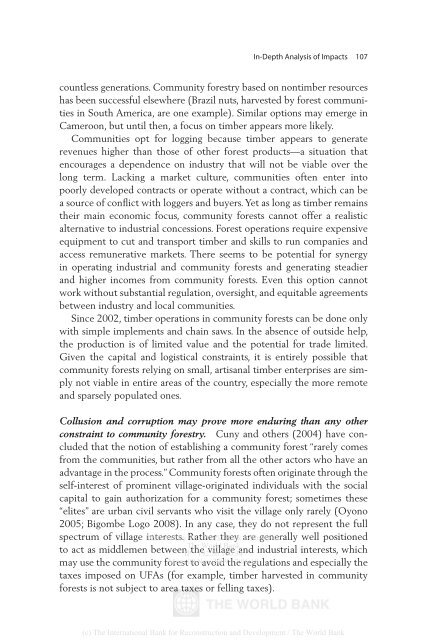The Rainforests of Cameroon - PROFOR
The Rainforests of Cameroon - PROFOR
The Rainforests of Cameroon - PROFOR
- No tags were found...
You also want an ePaper? Increase the reach of your titles
YUMPU automatically turns print PDFs into web optimized ePapers that Google loves.
In-Depth Analysis <strong>of</strong> Impacts 107countless generations. Community forestry based on nontimber resourceshas been successful elsewhere (Brazil nuts, harvested by forest communitiesin South America, are one example). Similar options may emerge in<strong>Cameroon</strong>, but until then, a focus on timber appears more likely.Communities opt for logging because timber appears to generaterevenues higher than those <strong>of</strong> other forest products—a situation thatencourages a dependence on industry that will not be viable over thelong term. Lacking a market culture, communities <strong>of</strong>ten enter intopoorly developed contracts or operate without a contract, which can bea source <strong>of</strong> conflict with loggers and buyers. Yet as long as timber remainstheir main economic focus, community forests cannot <strong>of</strong>fer a realisticalternative to industrial concessions. Forest operations require expensiveequipment to cut and transport timber and skills to run companies andaccess remunerative markets. <strong>The</strong>re seems to be potential for synergyin operating industrial and community forests and generating steadierand higher incomes from community forests. Even this option cannotwork without substantial regulation, oversight, and equitable agreementsbetween industry and local communities.Since 2002, timber operations in community forests can be done onlywith simple implements and chain saws. In the absence <strong>of</strong> outside help,the production is <strong>of</strong> limited value and the potential for trade limited.Given the capital and logistical constraints, it is entirely possible thatcommunity forests relying on small, artisanal timber enterprises are simplynot viable in entire areas <strong>of</strong> the country, especially the more remoteand sparsely populated ones.Collusion and corruption may prove more enduring than any otherconstraint to community forestry. Cuny and others (2004) have concludedthat the notion <strong>of</strong> establishing a community forest “rarely comesfrom the communities, but rather from all the other actors who have anadvantage in the process.” Community forests <strong>of</strong>ten originate through theself-interest <strong>of</strong> prominent village-originated individuals with the socialcapital to gain authorization for a community forest; sometimes these“elites” are urban civil servants who visit the village only rarely (Oyono2005; Bigombe Logo 2008). In any case, they do not represent the fullspectrum <strong>of</strong> village Delivered interests. by Rather <strong>The</strong> World they Bank are e-library generally to: well positioned<strong>The</strong> World Bankto act as middlemen between IP the : 192.86.100.34 village and industrial interests, whichmay use the community forest Mon, 09 to Nov avoid 2009 the 17:06:18 regulations and especially thetaxes imposed on UFAs (for example, timber harvested in communityforests is not subject to area taxes or felling taxes).(c) <strong>The</strong> International Bank for Reconstruction and Development / <strong>The</strong> World Bank
















